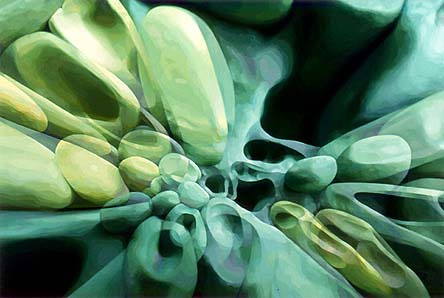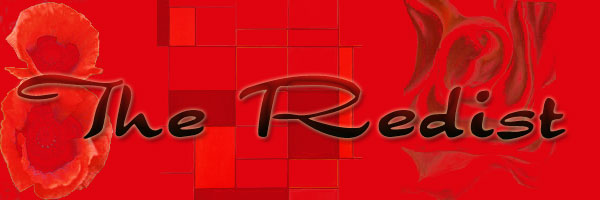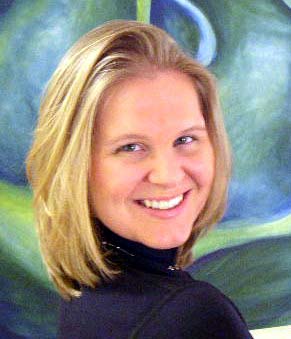seen at
Remote Viewing: Invented Worlds in Recent Painting and Drawing,
Whitney Museum of American Art, June 2-October 9, 2005
 Alexander Ross, Untitled, 2002, oil on canvas, 65 1/4 x 96 1/4 in.
Alexander Ross, Untitled, 2002, oil on canvas, 65 1/4 x 96 1/4 in. Painter Alexander Ross is arguably one of the most brilliant artists alive today.
His meticulous paintings are copied with rigorous detail from photographs of abstract hand-sculpted plasticine forms which recall organic, biological, primordial, algal, plant-like, and alien shapes. Using a strict color palette of primarily greens and light blues, the paintings are striking, captivating, and create an utterly seductive harmonious experience. Standing before them, the viewer cannot look away.
While portraying such evocative yet strange shapes, Ross strikes at something deeply and fundamentally human, located in the collective unconscious, which reminds us of humbler single-celled beginnings in tide-pools and soups. In this visual return to origin, questions are simultaneously asked and answered, coalescing into a beautiful, harmonious, powerful and timeless sentiment.
These paintings are also in many ways frightening, intimidating – massive in presence and rendered with such detail that one might suspect mechanical layering of paint strata – the peculiar character of the imagery is reinforced, unsettling the comforts of an otherwise return-to-womb state of mind. The viewer’s placid meandering about the field is disrupted with chasms and deep curves, dark areas which halt tranquil undulations or smooth planes. To regard the hulking mass of green form as it floats detached from the background, brings a haunting sense of nothingness or a no-man’s-land drifting into subconscious musings. It is a delicious interruption, a startle, a recall to reality and a conscious state. As Ross’s forms describe the fantasy imagery of our collective archetypes, they bring the shadow of our repressed thoughts to light, confronting the viewer with the things we’re afraid to think about. When reminded of how natural, mortal, fragile, and insignificant we are in the continuum of time and evolution, we cannot help feeling smaller, threatened, and at times shaken to the core.
The duality of these images is remarkable. At once, Ross soothes, entices, and tantalizes our sense of vitality, and challenges our very existence, reducing the proudest or most socialized psyche to its tiny constituent parts, exposing its vulnerability and its conflicting imprisonment and emancipation in a molded and elegant form.
To view Ross is an experience in immediacy: a stop-everything compelling look which envelops and engages relentlessly. The more abstract paintings are hypnotic, with translucent layers suggesting the passage of time and development, gradual and barely-perceptible changes and shifts. It is akin to an hallucination while meditating on the subject of the primordial, as areas move in and out of focus, seem to come alive and bring a sense of vibrant determinism forward, then recede into the darkness of the unconscious as soon as the viewer begins to grasp the image.
Ross may be the cutting edge of revitalization of the American Naturalist movement of the 1930s and 40s. Striking similarities exist in the planes of Ross’s forms and the curvilinear abstractions of Arthur Dove, as if Ross brought Dove into the third and fourth dimensions. Ross echoes the gentle touch and seductive paint-handling of Georgia O’Keeffe and the organic exaltation found in the photography of Edward Weston and Imogen Cunningham. Ross is not only aware of the history of organic abstraction, but carries it forward in a unique and self-possessed way – owning the images from inception through every stage of development and realization, he is truly inventing and embellishing his own world and context, elaborating upon an otherwise stark and flat space seen in pale blue backgrounds and milk white skies.
For such a stringent set of limitations on his subject matter and style, Ross is intensely innovative, challenging, and emotionally-charged. To do so much with such a simple strategy exhibits the most elegant of creative process, equaled only by natural order itself.
I feel Alexander Ross is required viewing for any painter or developing artist, as he opens the possibility of how much can be done with so little, expanding our very concept of painting making images today.
LINKS:
- Whitney Museum of American Art, New York NY
- Alexander Ross at Kevin Bruk Gallery, Miami FL
- Jerry Saltz on Alexander Ross, artnet magazine



